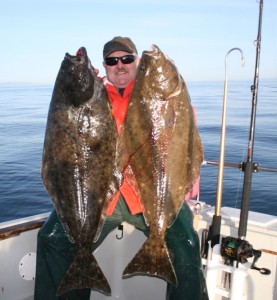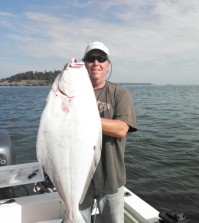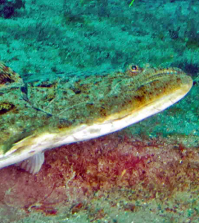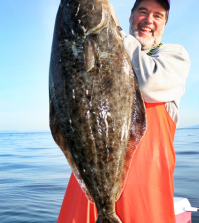My Favorite Halibut Rig (at least for this year)
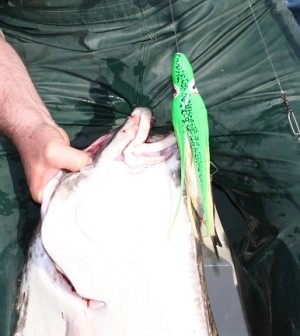
One of the most frequently asked questions I hear at the end of a fishing presentation, whatever the topic, is an inquiry about my favorite bait, favorite lure, favorite color, favorite size, or some combination of these things. The question usually draws a pretty long-winded answer—big surprise if you’ve ever heard me talk, right?—because there are lots of variables depending on the fishing conditions. Many years ago, however, when asked if I had a favorite halibut lure, my go-to answer became “A metal jig of some kind, probably a white one.” I caught a lot of flatties, including some triple-digit fish, on slabs of metal back in the eighties and nineties, so they were my weapon of choice for a long time.
Well, things have changed. A white metal jig is still a good way to go when you’re on the halibut grounds, but decades of deep-water jigging with heavy metal has played hell with my wrists, shoulders and especially my elbows, so these days I do a whole lot less jigging and a lot more bait-fishing than I did when I was younger and tougher.
And for the past three or four years the bait rig that’s out-fished anything else for me is a whole herring draped in a big plastic squid. Although I’ve used this off and on for some time, a 2011 trip to British Columbia’s Langara Island with fellow Salmon University instructor Terry Wiest was the event that made me a true believer in the magical powers of the herring and hoochie rig. On back-to-back days, one of them spent almost within sight of our “home” aboard the Oak Bay Marine Group’s Charlotte Princess, we boated halibut of 82 and 91 pounds, both of them from less than 100 feet of water and both on Gold Star/Yamashita Magnum Squid laced with blue-label-size whole herring.
Similar rigs produced similar results when the two Terry’s went looking for Langara halibut in 2012—except the fish were a whole lot smaller—and I haven’t used anything else on a halibut trip since.
So, when the 2013 version of Washington’s halibut seasons rolled around, opening day found fishing partner Dave Borden and I hovering at the edge of a drop-off in the middle of the Strait of Juan de Fuca, lowering a couple of black-label herring encased in Magnum Squid into the depths, and yes, it was once again confirmed that they work as well down here as they do in the wilds of British Columbia. No eighties or nineties, but we couldn’t complain about a 30 and a 38 on opening morning.
There’s no denying that Pacific halibut are eating machines, and as such they can be—and are—caught on a wide range of baits and lures. But, because they use sight, sound and scent to zero in on a prospective meal, you can improve your odds by offering them some kind of bait-lure combination and fishing it as a rig that will appeal to all three of those senses. The herring-and-squid rig is just one of those combinations (see Bait/Lure Combos for Halibuton the Updates menu of this website), but certainly one of the best.
As you’ve probably already guessed, there’s nothing fancy or complicated about my favorite halibut rig. It’s nothing more than a whole herring pinned to one or two good-sized hooks, with a large plastic squid body slid down the leader and over a good portion of the bait. Both herring and plastic squid bodies come in different sizes, and I try to match the size of the squid to the size of the herring. I prefer large (black label) herring for halibut, and with that size bait my first choice in a squid is the 9 ½-inch Yamashita Magnum Squid, although there are other models in that size range that will do the job. If all I have for bait are blue-label herring, I go with the Magnum Squid in the 8-inch size. Again, I want the squid covering most, but not all, of the herring, so some of that fresh-bait smell can escape as I’m bouncing the rig along the bottom.
While that herring is exuding its enticing scent, the plastic squid adds visibility, not only in the form of additional color but also in the action from all those wiggling “tentacles.” While we’re on the subject of color, by the way, I should mention a few of my favorites. I’ve always been a fan of plain white and pearl for almost any halibut-fishing situation, but something with a little bit of luminescence is also good. Almost any shade of green is a close third choice as a halibut color, and my go-to halibut hoochie last year was the Double Glo Green Spatterback (color 8142) Magnum Squid. I also like the 8140, which is a slightly lighter shade of green in a Double Glo Spatterback paint scheme.
Besides adding color and action, that plastic sheath around your bait protects it and helps to keep it on the hook longer. Rockfish, sculpins, crabs and lots of other things skulking down there may also take an interest in that juicy herring you’re dragging along the bottom, and they’ll have a tougher time ruining your bait if it’s partially encased in plastic. I’ve even had baits inside a squid body go pretty much unscathed through an entire fight with a hooked halibut.
Even if your bait is stripped from the hooks by a hard strike or short-term hook-up, though, you don’t have to reel up and check your rig. One of the most important advantages of this and most other bait-lure combinations is that even if you lose the bait, you still have a perfectly effective artificial lure down there dancing around for any hungry halibut to see. Whenever you miss a strike or lose a fish with this rig, LEAVE IT DOWN THERE a little while and you just may get a second chance at him.
I use both single and two-hook rigs when fishing herring for halibut, depending mostly on the size of the bait. With larger herring (over about nine inches) I usually go with two hooks, most often a pair of 9/0 or 10/0 Owner SSW Cutting Points. I run the top hook up through the head near the tip of the snout and the trailing hook into the side of the bait an inch or so from the tail. When the bait is smaller, I prefer one big hook to a pair of smaller ones, so I go with the same 9/0 or 10/0 Owner. I rig the bait by running the hook up through the head near the snout, than bring it around and run it through the same hole again. I then (carefully) pull a little leader through that double loop so that I can bring the hook back and seat it into the side of the bait near the tail.
Rigging the plastic squid is easy, as long as you remember to do it BEFORE you tie off the top end of your leader. First, slide a large bead of some kind down the leader to act as a stopper to keep the squid body from being pulled down over the hooks (a size 10 Corky works pretty well). Then it’s just a matter of running the leader up through the squid body and out the hole at the top and sliding it down until the bead is in the head end of the squid. After the squid is in place, make whatever adjustments necessary to ensure that hook points are in the clear. When everything is in place, I like to have about two inches of the herring hanging out behind the end of the squid’s tentacles.
So far all we’ve talked about here is a squid-and-herring combo, but a squid-and-salmon belly rig can be an effective alternative. A strip of salmon belly is, in fact, a much tougher bait than even a well-brined and tough whole herring, and will usually stay on the hook until you cut it off with a knife. I like to fish a large (eight- to nine-inch) belly strip with two hooks, one fore and one aft, and I’ll stick to two hooks even with smaller strips, pinning the top end of each strip on one of the hooks, so that the lower one hangs out the bottom of the squid body.
While a good herring bait or salmon belly emits a lot of halibut-attracting scent, a plastic squid fresh out of the package may not smell all that appetizing; it’s there to be seen, not smelled, so I apply a generous coating of Smelly Jelly to every squid rig I send down into the depths. If I remember to do it, I may throw a couple of them into my bait box at the start of the day and let them marinate an hour or two in order to cover up the plastic smell and soak up some of that fresh-bait flavor and aroma.
There are several ways to fish a bait rig for halibut, but I prefer the good ol’ wire spreader with a cannonball sinker on a dropper at the bottom and a short, monofilament leader from the spreader to the bait. I like no more than about 18 inches of 60-pound Trilene Big Game between the swivel at the end of the spreader bar and the nose of the plastic squid. Water depth, wind and current speed, line drag and other factors determine the size cannonball you’ll need to keep the rig down where it belongs as you bounce it along the bottom, but it might be anywhere between 12 and 48 ounces, maybe more in really deep water. Whenever possible, fish the rig downhill to reduce hang-ups.
Oh, and you may remember that earlier in this story I mentioned something about halibut using sight, scent and sound to zero in on a source of food. I get sound out of my bait-and-squid rigs by bouncing that heavy sinker on the ocean bottom at regular intervals, hoping to generate the drum beat that means “Breakfast Is Served.”
Even though it’s a bait-lure combination, fish the herring-squid rig like bait and act accordingly when a halibut goes for it. I like to free-spool a yard or two of line and drop the rod tip to the water at the first sign of strike, wait for a solid thump-thump to be sure he’s still there, and let him have it with a solid upward thump of my own to stick the hook where it belongs.


